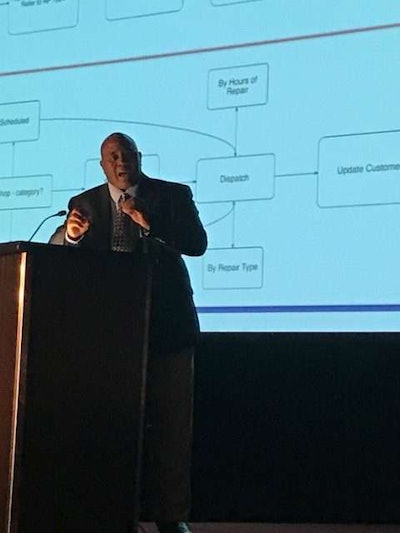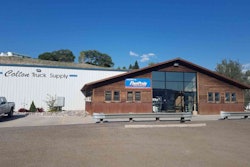 Homer Hogg of Travel Centers of America speaks at the TMC Fall meeting about shop best practices.
Homer Hogg of Travel Centers of America speaks at the TMC Fall meeting about shop best practices.Attendees at the ATA’s Technology & Maintenance Council fall meeting in Orlando learned more about the organization’s efforts to create a logical and systematic approach to scheduling shop workload.
The efforts take into consideration the available labor, skill levels, the complexity of the work and the urgency of the customer’s needs.
A TMC Recommended Practice is expected to be passed and move on to the appeals process based on the task force’s recommendation.
“The scope of the repair process can be very long and daunting,” says Matt Jablon, Texas regional manager for Daimler Trucks North America.
“We believe the service provider has enough valuable information to provide the customer with a time of repair so we want to recommend practices that will help all the way down to the customer.”
Greg Johnsen, regional service manager for Maverick Transportation, says that it’s important for shop managers to find out their customer’s needs, not just what work is needed, but even as far as how they want to be communicated with.
“How does the customer want to be communicated with,” he asked. “You should have a secondary follow up contact phone number, email or however they want to hear from you. If our business model changes for whatever reason, we should contact our customers.”
Homer Hogg, TA/Petro’s manager of technical development, emphasized that all shops are different and require some different approaches, but believes the RP can be helpful.
The RP will recommend taking a look at prioritization.
“Historical data will give the dealers the ability to look at past workload so that shop capacity can be handled accordingly,” says Scott Witt, Excel Truck Group, senior vice president.
“It helps shops identify jobs. When we can communicate it is very crucial to success.”
Jablon agreed that understanding a tractor’s past history helps shops throughout the repair and maintenance process.
“The backbone to the RP is about historical data and how important it is for any shop provider to know what’s coming down the pike.”
The group’s recommendation includes shop layout designs that could help with efficiency and response time.
“Rapid repair is very important,” Johnsen says. “With ELDs, the driver’s only have a certain amount of time so it’s important to get them in and out as fast as possible. Quick repair is very important.”
Scott Witt, Excel Truck Group’ senior vice president, says having a specific quick bay area is more important than ever.
“One of the keys to rapid diagnosis is putting the quick bay process in,” he says.
But designing the shop’s layout needs to be handled in a manner that puts technicians in the right place.
“The critical thing is to have options,” says Peter Savage, Clarke Power Services, director of fleet solutions.
“You can set your shop up based on time of repair or however, but have options so that techs can be prepared to work based on their particular skillset.”
Hogg says the implementation of new plans is just one step in a continuous process.
“The culture of continuous improvement is critical,” he says. “Continuous improvement and change go hand in hand. It keeps you moving beyond implementation and on to continued customer satisfaction.”









